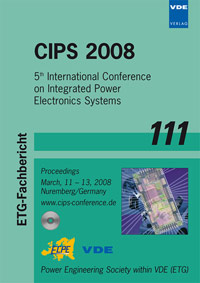Modularity bridging future Power Electronics in automotive volume applications – speeding up HEV applications
Conference: CIPS 2008 - 5th International Conference on Integrated Power Electronics Systems
03/11/2008 - 03/13/2008 at Nuremberg, Germany
Proceedings: CIPS 2008
Pages: 5Language: englishTyp: PDF
Personal VDE Members are entitled to a 10% discount on this title
Authors:
Rekofsky, Andreas; Brey, Roland (Continental)
Thoben, Markus (Infineon Technologies AG)
Mertens, Christian (Volkswagen AG)
Löcher, Günter (EPCOS AG)
Abstract:
In the face of the global warming, discussions on zero emissions on our roads are targeting the reduction of fuel consumption because it correlates with CO2 emissions, the main contribution to the greenhouse effect. In this case primarily HEVs will be seen as potential force bridging these requirements. After the successful market introduction of some very specific applications, a broad market penetration is the next step. Target is to find concepts which are on one hand competitive for smaller production volumes and on the other hand flexible enough to fit to a platform concept with a high total volume, split into alternative versions with different geometries and functionalities. It is obvious that there is a need for different power ratings because of the great variety of cars and their grade of electrification. If one assumes that there would be for every car manufacturer and car model individual power electronics, it is obvious that this would lead to high cost. Additionally temperature and lifetime requirements are increasing. As the market will not accept premium prices, there is a substantial challenge for designers to provide technologically innovative and cost-efficient solutions. This implies the need for a modular power electronic approach for harsh environment which can be manufactured at a reasonable low price. Inside the InGA project (public funded by the BMWI) the main aim is to reduce system costs by integrating the electronic at the electrical machine for generating hybrid drivetrain units. This means to develop generic technology and modular systems – built up from components that can be manufactured essentially with similar configurations, but with different qualities, to meet the specific performance, lifetime and cost requirements of the different applications. To master all the challenges, a consortium was built with: Continental – Division Powertrain as consortium leader; Infineon AG; SiCED GmbH; Epcos AG; Siemens AG; Technical University Carolo-Wilhelmina to Brunswick and Volkswagen AG. Based on that approach scalable mechatronic, high temperature electronic, power electronic, DC link capacitor, cooling technology and interface description will be part of the presentation. Also the crossover of modularity to higher integration of functional modules will be presented together with an outlook on the next steps to be done.


